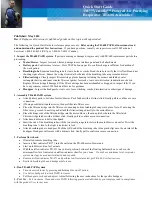
2
2
UNITS INSTALLATION
2.
UNITS INSTALLATION
¬
WARNING:
-
Check to ensure that the accessories are packed with
the indoor unit.
-
Do not install the indoor units outdoors. If installed
outdoors, an electric hazard or electric leakage will
occur.
-
Consider the air distribution from each indoor unit to
the space of the room, and select a suitable location
so that uniform air temperature in the room can be
obtained. It is recommended that the indoor units be
installed 2.3 to 3 meters from the floor level. If the unit
is installed higher than 3 meters, it is also
recommended that a fan be utilised to obtain uniform
air temperature in the room.
-
Avoid obstacles which may hamper the air intake or
the air discharge flow.
-
Pay attention to the following points when the indoor
units are installed in a hospital or other places where
there are electronic waves from medical equipment,
etc.
-
Do not install the indoor units where electromagnetic
wave is directly radiated to the electrical box, remote
control cable or remote control switch.
-
Prepare a steel box and install the remote control
switch in it. Prepare a steel conduit tube and wire the
remote control cable in it. Then connect the ground
wire with the box and tube.
-
Mount suspension bolts using M10 (W3/8) as size, as
shown below:
-
Do not put any foreign material into the indoor unit
and check to ensure that none exist in the indoor unit
before the installation and test running. Otherwise a
fire or failure, etc., may occur.
-
Install a noise filter when the power supply emits
harmful noises..
-
This unit is exclusive non electrical heater type indoor
unit. It is prohibited to install a electrical heater in the
field.
CAUTION:
-
Do not install the indoor units in a flammable
environment to avoid a fire or an explosion.
-
Check to ensure that the ceiling slab is strong
enough. If not strong enough, the indoor unit may fall
down on you.
-
Do not install the indoor units, outdoor unit, remote
control switch and cable within approximately 3
meters of strong electromagnetic wave radiators such
as medical equipment.
-
Do not install the indoor units in a machinery shop or
kitchen where vapor from oil or mist flows to the
indoor units. The oil will deposit on the heat
exchanger, thereby reducing the indoor unit
performance, and may deform. In the worst case, the
oil damages the plastic parts of the indoor unit.
-
To avoid any corrosive action to the heat exchangers,
do not install the indoor units in an acid or alkaline
environment.
-
When lifting or moving the indoor unit, use
appropriate slings to avoid damage and be careful
not to damage the insulation material on units
surface.
2.1.
UNIT INSTALLATION
2.1.1.
FACTORY-SUPPLIED ACCESSORIES
Accessory
Quantity
Purpose
Adjustment
Bolt for
Installation
4
For Adjusting the
Flat Level of the
Unit
2.1.2.
INITIAL CHECK
Install the indoor unit with a proper clearance around it for
operation and maintenance as shown in Service Access
panel.
RPF
RPFI
Provide a space so that air can flow smoothly
Square
washers
Wooden Bar
(60 mm to 90 mm Square)
Wooden Beam
Sling Bolt
(W3/8 or M10)
For Concrete Slab
150~160mm
Concrete
Anchor Bolt
Steel
I-Beam
Suspension Bolts
(W3/8 or M10)
Nuts
Wall
Wall
More Than 300
More Than 300
630
Wa
ll *
Ceiling
Upward Air Outlet
Short Flexible
Duct
640
Wa
ll
More Than 240
More Than 240
Service Space for
Electrical Box
Piping Space
Front Air Outlet
620
More Than 240
More Than 240
Service Space for
Electrical Box
Piping Space
Ceiling
Содержание RPF(I)-1.0FSN2E
Страница 2: ......
Страница 6: ......
Страница 67: ......
Страница 68: ...PMML0159A rev 1 06 08 Printed in Spain ...









































